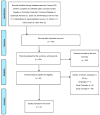Physical Rehabilitation Programs for Bedridden Patients with Prolonged Immobility: A Scoping Review
- PMID: 35682005
- PMCID: PMC9180781
- DOI: 10.3390/ijerph19116420
Physical Rehabilitation Programs for Bedridden Patients with Prolonged Immobility: A Scoping Review
Abstract
Bedridden patients usually stay in bed for long periods, presenting several problems caused by immobility, leading to a long recovery process. Thus, identifying physical rehabilitation programs for bedridden patients with prolonged immobility requires urgent research. Therefore, this scoping review aimed to map existing physical rehabilitation programs for bedridden patients with prolonged immobility, the rehabilitation domains, the devices used, the parameters accessed, and the context in which these programs were performed. This scoping review, guided by the Joanna Briggs Institute's (JBI) methodology and conducted in different databases (including grey literature), identified 475 articles, of which 27 were included in this review. The observed contexts included research institutes, hospitals, rehabilitation units, nursing homes, long-term units, and palliative care units. Most of the programs were directed to the musculoskeletal domain, predominantly toward the lower limbs. The devices used included lower limb mobilization, electrical stimulation, inclined planes, and cycle ergometers. Most of the evaluated parameters were musculoskeletal, cardiorespiratory, or vital signs. The variability of the programs, domains, devices and parameters found in this scoping review revealed no uniformity, a consequence of the personalization and individualization of care, which makes the development of a standard intervention program challenging.
Keywords: bedridden persons; programs; rehabilitation; rehabilitation exercise; review.
Conflict of interest statement
The authors declare no conflict of interest.
Figures
References
-
- Pereira F., Carvalho V., Soares F., Machado J., Bezerra K., Silva R., Matos D. Advances in Engineering Research. Nova Science Publisher; Hauppauge, NY, USA: 2013. Development of a mechatronic system for bedridden people support; pp. 138–144.
-
- Andone I., Popescu C., Spinu A., Daia C., Stoica S., Onose L., Anghel I., Onose G. Current aspects regarding “smart homes”/ambient assisted living (AAL) including rehabilitation specific devices, for people with disabilities/special needs. Balneo Res. J. 2020:444–449. doi: 10.12680/balneo.2020.3760. - DOI
-
- Orun B., Roesler C., Martins D. Review of Assistive Technologies for Bedridden Persons. ResearchGate. 2016. [(accessed on 11 February 2022)]. Available online: https://www.researchgate.net/profile/Bilal-Orun/publication/283459329_Re....
-
- Jiang C., Xiang Z. A Novel Gait Training Device for Bedridden Patients’ Rehabilitation. J. Mech. Med. Biol. 2020;20:1–12. doi: 10.1142/S0219519420500244. - DOI
Publication types
MeSH terms
LinkOut - more resources
Full Text Sources
Medical


